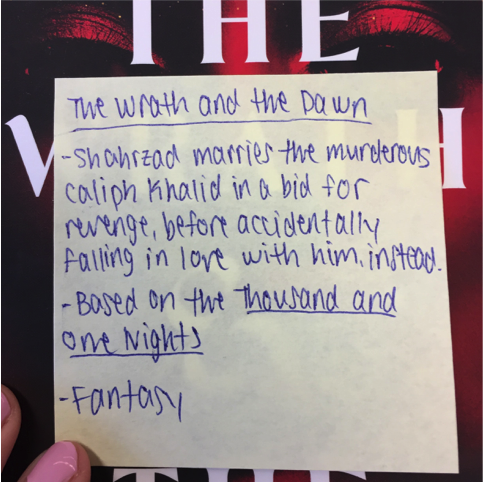Diversity Outreach Project
This Diversity Outreach Project was my final project for LIS 564, Multicultural Resources for Youth. I partnered with a local middle school teacher to add books by and about people from marginalized racial and ethnic groups to his classroom library. I set up a fundraiser on a crowd funding website, posted about the fundraiser on social media, and used the $100 I raised to purchase five books for the classroom library. Additional details about the project can be found in the reflection I've posted below.
For my diversity outreach project, I worked with an eighth grade humanities teacher at WMS. Since WMS is made up of approximately 80% white students (OSPI), I chose five #ownvoices books by people of color to donate to my colleague's classroom library in order to provide his students with “window” books to read (Bishop, 1990). These books were The Wrath and the Dawn by Renée Ahdieh, The Star-Touched Queen by Roshani Chokshi, Long Way Down by Jason Reynolds, I Am Not Your Perfect Mexican Daughter by Erika L. Sánchez, and The Hate U Give by Angie Thomas. My book selections reflected a mix of races and ethnicities - Middle Eastern, Indian, Mexican, and African American - and covered fantasy as well as realistic fiction. I deliberately chose to include two fantasy novels because of Nel’s (2017) point that genre acts as the “new Jim Crow” and because I wanted to show, as Welch (2016) discussed in her TED talk, that adventures do not just belong to white children.
In order to purchase the books I donated to my colleague's classroom, I created a fundraiser on the crowdfunding website YouCaring.com and shared the link on my Facebook profile each week along with updates about my project. I did this fundraising over the course of a month and once my project was funded, I sought feedback from my colleague on my ideas for prospective titles before purchasing the books from our local independent bookstore. Since I was unable to book talk the books, I wrote blurbs on post-it notes with some talking points since my colleague was unfamiliar with most of the titles. I was able to deliver the books to him earlier this week.
My biggest challenge initially was persuading people to donate to my fundraiser. I shared on both Facebook and Twitter at first, but since all of my donations were coming from Facebook, I decided to abandon Twitter. I have met far fewer of my Twitter followers in person, whereas I have met almost all of my Facebook friends in person, so I concluded that utilizing my personal connections would be most effective in funding my project. I found I was most successful with my final post, when I was most specific about what I planned to do with the donations: with only $40 at that point, I stated that I hoped to be able to purchase one more book and then described some of the books I was interested in. After that post, I made it the rest of the way to my goal within 24 hours.
A success that I had was in pitching prospective titles to my colleague. As I previously mentioned, he was unfamiliar with almost all of the books; he had only heard of The Hate U Give because the school’s librarian had book talked it in the seventh and eighth grade language arts classes. In his language arts classes, my colleague emphasizes books with “literary merit,” so not only did I have to explain what each book was about and which aspects of the books might appeal to students in order to get students excited about reading them, I had to sell the books to him by explaining how each book would stretch his students’ thinking. Since my plan upon finishing this program is to work in school libraries, this was excellent practice for one of the roles I will play in my future career.
Because I only delivered the books this week, I have not had the opportunity to see the impact of my project. When I delivered the books to my colleague, it sounded like he already had some students in mind to suggest them to. He also mentioned to me in an email that he has several fantasy readers, and the two fantasy books I donated might help those students to branch out in another direction within the genre they might not have previously considered. Since I work at WMS fairly regularly, it will be easy for me to check in at a later time to assess the impact of this project on this classroom.
As I stated in my proposal for this project, precedent for children’s and young adult literature being used to develop cultural competence exists in both Dresang (2013) and Wee (2015). Both researchers used children’s books to prompt discussion among graduate students and elementary school students, respectively. In these cases, students mentioned that reading these books caused them to reconsider their preconceptions about certain groups they were unfamiliar with. Reading The Wrath and the Dawn, a retelling of the Thousand and One Nights, could help counter images of the Middle East as barbaric and wartorn, with its Middle Eastern-inspired setting coming vividly to life as the main character, Shahrzad, tries to help her husband, the Caliph, try to break a curse on their kingdom. The Hate U Give could help students gain greater empathy for people who are involved in gang activity, as Thomas examines in heartbreaking detail the reasons Khalid felt that joining a gang was his only option. I Am Not Your Perfect Mexican Daughter deals directly with mental illness and suicide, which counters misconceptions of mental illness as a “white” issue.
All five books portray young people making impossible choices and provide windows to my colleague's mostly-white, mostly-affluent students into lives they might never be able to imagine otherwise. As Doll (2013) states, “[p]art of the role of young adult fiction is as a parental or teacher assist, to help teen readers understand what happens to the characters in the books, to help them learn from those experiences….” In a time in which police brutality, immigration, and Muslim bans are among the top headlines on an almost daily basis, reading these books can help students who are not directly impacted by these issues learn how to engage with them in a constructive way. Across town from WMS is another middle school with a rather different student body makeup: only 48% of its students are white, while just over a quarter of its students are Latinx or Hispanic, 13% are Asian, and 7% are multiracial. Almost 60% of their students are on free or reduced-price lunch, and 12% are English Language Learners (OSPI). The students who are impacted by these issues dominating the news live in our community, and my colleague's students might encounter them infrequently - if at all - due to the segregation of our city's neighborhoods. Hopefully, these books will leave his students with empathy for their neighbors.

The books I purchased for donation to the classroom library.
More About These Books
An example of how I included my talking points for the books in lieu of a book talk. If I were to do this again, I'd probably do something a little more eye-catching like a bookmark instead.
Ahdieh, R. (2015). The wrath and the dawn. New York: Putnam.
Bishop, R. (1990). Windows, mirrors, and sliding glass doors. Perspectives: Choosing and Using Books for the Classroom, 6(3), ix-xi.
Chokshi, R. (2016). The star-touched queen. New York: St. Martin’s Griffin.
Doll, J. (2013, Apr 2). The author who’s teaching boys how to talk about rape. The Atlantic. Retrieved from https://www.theatlantic.com/national/archive/2013/04/author-whos-teaching-boys-how-talk-about-rape/316714/
Dresang, E. (2013). Opening doors to understanding. In J. Naidoo and S. Dahlen (Eds.), Diversity in youth literature: Opening doors through reading (pp. 17-29). Chicago: ALA Editions.
Nel, P. (2017). Was the Cat in the Hat black?: The hidden racism of children’s literature and the need for diverse books. New York: Oxford University Press.
Office of Superintendent of Public Instruction. (2017). Washington state report card. Retrieved from http://reportcard.ospi.k12.wa.us/summary.aspx?groupLevel=District&schoolId=1&reportLevel=State&yrs=2016-17&year=2016-17
Reynolds, J. (2017). Long way down. New York: Atheneum.
Sánchez, E. L. (2017). I am not your perfect Mexican daughter. New York: Knopf.
Thomas, A. (2017). The hate u give. New York: Balzer & Bray.
Wee, J. (2015). Thinking about immigrant students through literature discussion in a Korean classroom. Bookbird: A Journal of International Children’s Literature, 53(3), 82-85.
Welch, B. [TEDx Talks]. (2016, April 28). Missing adventures: Diversity and children’s literature [Video file]. Retrieved from https://www.youtube.com/watch?v=Yq2opVinciA